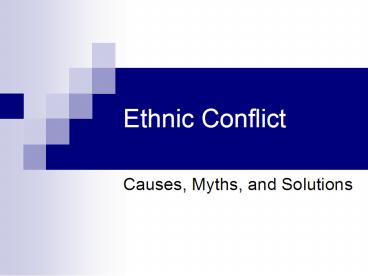Ethnic Conflict - PowerPoint PPT Presentation
1 / 13
Title: Ethnic Conflict
1
Ethnic Conflict
- Causes, Myths, and Solutions
2
What is ethnic conflict?
- An ethnic conflict is a conflict in which a
sub-national (minority) group challenges the
policies of the state or other political actors,
usually by asking for group rights or recognition
of some sort.
3
- 60 percent of the worlds 20 million refugees are
fleeing ethnopolitical conflicts and repression
Top photo a woman from Abkhazia, Georgia who was
forced to flee her home bottom right, Chechen
refugees. Photos Fred Clarke, International Red
Cross
4
- Since the end of World War II, 16.5 million
people have died in internal conflicts, compared
with 3.3 million in interstate wars. There have
been about 122 civil wars since 1945, compared
with 25 conventional wars. Many are between
different ethnic groups.
Youths in Kabul, Afghanistan, sift through rubble.
5
- There are currently about 250 active
ethnopolitical movements using various forms of
protest and rebellion.
- Ethnic conflict occurs in all regions of the
world - Serious conflicts, 1995-98
- 16 Europe
- 10 Middle East
- 31 Asia
- 31 Africa
- 7 Latin America
6
Myths of ethnic conflict
- MYTH Ethnic conflict occurs because of ancient
tribal or ethnic hatreds. - NO. Ethnic conflicts nearly always occur because
of discriminatory economic and political policies
pursued by modern-day states.
Former Serbian President Slobodan Milosevic.
Photo BBC.
7
What causes ethnic conflict?
- State-building nationalism
- Peripheral nationalism
- Competition over resources
- discrimination
- Note Nationalism is often (but not always) the
framing ideology of ethnic conflict
8
Myths about Ethnic Conflict
- MYTH There is more ethnic conflict today than
in any other time, and the number of such
conflicts keeps increasing. - NO. The rate of ethnic conflict rose steadily
from the 1950s-early 1990s and has since started
dropping.
Source Minorities at Risk Project
9
Source Minorities at Risk Project
10
Myths of ethnic conflict
- MYTH Ethnic conflict usually occurs between two
or more different social groups or ethnic
communities. - NO. Most ethnic conflicts occur between a
minority group (or PART OF A MINORITY group, and
a state (and its forces).
A Russian tank in Chechnya.
11
Modes of ethnic conflict
- Conventional politics
- Nonviolent protest and direct action
- Rebellion
- 70 ethnic groups have waged armed conflicts for
autonomy or independence since the 1950s (not
including liberation movements of former European
colonies)
12
Note the most common form of ethnic conflict is
NOT violence
- Of 161 groups pursuing self-determination in
1998-2000, only about 41 (a quarter) used
violence. The rest used conventional politics and
nonviolent protest.
Kurdish-rights activist Osman Baydemir on the
campaign trial in Diyarbakir, Turkey, March 2004.
Photo NFWatts
13
Resolving ethnic conflict
- Settlement that acknowledges collective rights
and provides institutional means for pursuing
interests - Regional autonomy
- Federalism (Hechter)
- independence
- Only 5 new states emerged from ethnic conflict in
the last 40 years (East Timor, Slovenia, Croatia,
Eritrea, Bangladesh)































